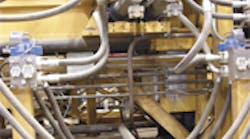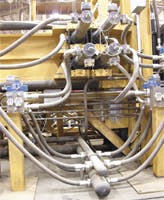Hydraulics is often perceived as a formidable power source, but one that is difficult to control precisely. It is excellent for applying strong forces or moving heavy objects, but has sometimes had the reputation of being prone to shock and expensive to maintain. That perception may have had some truth to it years ago, but a new class of electronic controls is giving hydraulics a new birth as a precise, high performance motive force for many heavy-duty machine applications.
This is particularly important in the current economy, where retrofitting a control system can make an older machine perform as well or better than a new one at much lower cost than purchasing a new machine. And for new and old machines alike, the new generation of electrohydraulic controllers can be programmed to add new automation features that could not have been achieved before.
Benefits of hydraulics
One company celebrating the productivity improvements that come with precise hydraulic control is Valley Hay Co., Harrisburg, Ore. The company deals in all types of forage products used for animal feed, including alfalfa, fescue grasses, and hay. The hay processed by the company is primarily sent overseas. To minimize shipping costs, Valley Hay compresses the bales by approximately 50% before loading them into shipping containers.
The company has employed hydraulic machines for compressing the bales for many years. No two bales of forage products compress exactly the same way. Alfalfa is the easiest because it contains little air. At the other end of the spectrum, rye grass is the most difficult because its stalks are dry and stiff. Even when compressing the same type of material, each cycle compresses somewhat differently because no two bales are exactly the same weight.
Valley Hay’s four older hydraulic presses use a PLC-based control system for the machines’ hydraulic rams. This system cannot vary the compression speed with each bale to account for the variability in material being compressed. The older presses operate at the same, relatively slow constant speed from bale to bale. In addition, the old PLC controls do not smoothly control the hydraulic system. This results in more shock and, consequently, more down time and repair expenses.
Looking for better control
As Valley Hay’s principals began the development of a new high-capacity press, they looked for a better means of controlling the machine’s four 13-in. bore, 72-in. stroke hydraulic cylinders. The new cylinders needed to be synchronized within a tolerance of ¼ in. and operate as quickly as possible based on the agricultural material being compressed. This would require hydraulic controls that are generally more precise and versatile than those typically used in the agriculture industry.
One of the principals, Trevor Derstine, came up with an idea: He was aware that the forest products industry uses sophisticated hydraulic controls, and had a hunch that these controls might solve his own problem. It was with this intention that a local hydraulics distributor suggested they consider motion controllers made by Delta Computer Systems Inc., Vancouver, Wash.
Delta’s RMC150 programmable motion controller was selected to control the hydraulics, and Derstine asked Delta to provide technical assistance with programming the motion using RMCTools, Delta’s programming software package. Initially, Delta suggested the RMC’s standard synchronized move instructions to drive the cylinders. However, these instructions control at a certain speed and do not necessarily allow the hydraulics to go as fast as possible. This resulted in slow motion, and the presses began to show tracking errors as the compression force on the rams increased. Delta’s chief motion control technologist, Peter Nachtwey, quickly came up with a solution to the problem by developing a “synchronization quick move” algorithm.
An algorithm to the rescue
The algorithm that Nachtwey developed for the hay press is, in essence, an open-loop command applied selectively to different valves, which enables the hydraulics to move the rams at maximum speed. The algorithm always gives full control voltage to the axis that is the furthest behind, and regulates the control voltage to the other axes so that all axes remain synchronized. In contrast, a standard closed-loop command cannot move at maximum velocity, and yet retain control.
Delta then implemented the algorithm within an RMCTools user program. User programs are similar to macros in conventional computer languages, but with a graphical interface. Delta’s user programs make it easy to create motion sequences and are powerful enough to implement advanced, high-speed control algorithms. This feature allowed Delta to quickly implement the algorithm, whereas implementing the algorithm as a standard instruction in the controller’s firmware would have required more resources and time. In the future, Delta Computer Systems plans to add this algorithm to the RMC’s command set so other machine builders can easily access this feature.
After implementing the algorithm, Delta’s engineer tested the algorithm using the RMC’s built-in simulator while working at his office desk. Because the algorithm was pre-tested and used existing tuning gains, the algorithm worked flawlessly the first time it was operated on the real system hardware. The algorithm achieved a synchronization tolerance of less than 0.005 in., much less than the required 0.25 in.
Impressive improvements
The new synchronized multi-axis move algorithm worked so well that the Valley Hay machine designers decided to apply the algorithm to four other hydraulic cylinders, which eject the bale after the compression is completed, and to the retract stroke on the main press cylinders. To control these additional axes, Valley Hay added a second RMC150 motion controller to the machine. The single-axis pre-compressor actuator that pushes the bale into position in the press also implements closed-loop motion. A PLC provides basic supervisory control, simply instructing the Delta RMCs to start their programs.
The operating results were immediate and impressive. The compression cycle time had taken more than 300 sec to complete. With the new controllers, the cycle takes about 53 sec with rye grass. At this rate, a whole shipping container can be loaded in just 45 min — far less than the previous average of 2 hr. “This gives us a real economic advantage over our competitors,” says Derstine. “We’re also saving costs on production. Fewer people are needed to operate the machine, and we have less material waste. Plus, we package the bales in sleeves instead of traditional strapping and shrink wrap — and this saves money.”
“I have to say that Delta is phenomenal in the controller business,” continues Derstine. “They are highly responsive as a team, plus they have flexible products that can easily be configured to suit our needs. Now, our system is moving more than twice as fast as it did before and produces zero pressure spikes. This lengthens the life of our machine.”
Valley Hay has had such a positive experience that they plan to retrofit their older presses to use Delta controllers as soon as they can, starting with at least one more press in the winter of 2008-2009.
This information was submitted by Jacob Paso, of Delta Computer Systems Inc. For more information, visit www.deltamotion.com.


